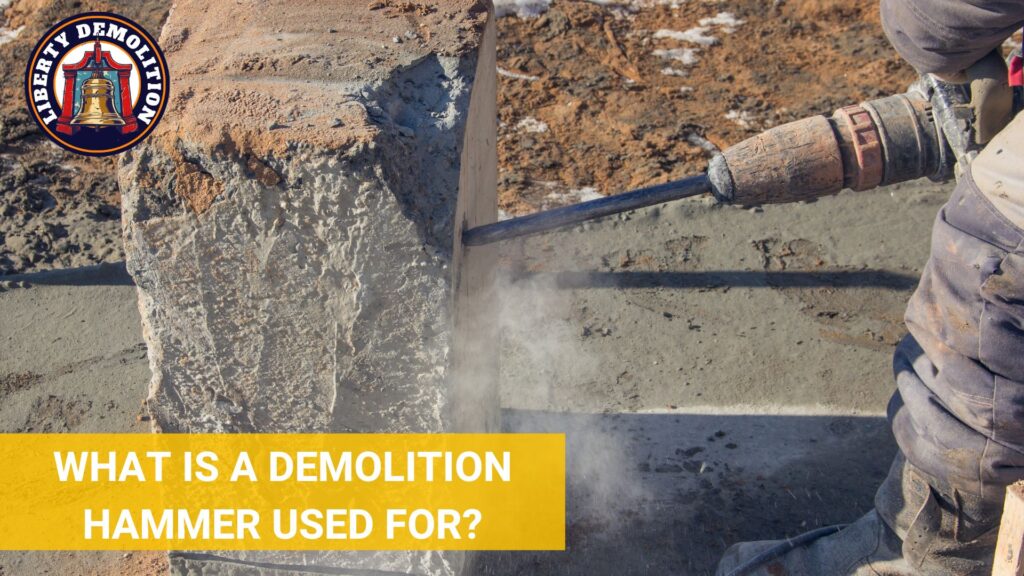A demolition hammer is a powerful tool designed specifically for breaking down large walls, concrete floors, and other sturdy materials. Its primary purpose is to make the demolition process quicker and more efficient.
Curious to know more? Let’s get into the details.
What Is a Demolition Hammer?
A demolition hammer, often referred to as a concrete breaker or jackhammer, is a power tool used in construction and renovation projects. Its primary function is to break and remove tough materials, such as brick, concrete, and stone, which make it an important tool for demolition contractors and DIY enthusiasts alike.

What Is a Demolition Hammer Used For?
A demolition hammer serves a variety of purposes in construction, renovation, and demolition projects, which include the following:
Breaking through Concrete, Tiles, and Brickwork
- Concrete: Often found in walls, floors, and foundations, concrete can be challenging to break down. With its strong impact force, a demolition hammer can crack and break concrete, which makes it easier to remove.
- Tiles: Whether renovating a bathroom or redoing a kitchen floor, a demolition hammer can lift and break tiles without much hassle. This helps in ensuring a clean slate for new installations.
- Brickwork: Older buildings or walls made of brick can be difficult to dismantle. The demolition hammer can effortlessly break through layers of brick, which helps in both full and partial demolitions.
Trenching and Digging Tasks
- Trenching: A trench is required when laying down pipes, cables, or other underground utilities. A demolition hammer can assist in creating these trenches by breaking the ground, especially if it’s made of compact soil or has layers of tough materials like clay or rock.
- Digging: While shovels and spades are common digging tools, a demolition hammer can speed up the process, especially in difficult terrains. It can break through hard ground, so digging deeper becomes easier.
Removing Plaster and Other Surface Materials
- Plaster Removal: Old homes or buildings might have layers of plaster that need to be removed before renovation. A demolition hammer can effectively chip away at this plaster without damaging underlying structures.
- Surface Materials: Beyond plaster, there may be other materials like stucco, adhesives, or old paint that need to be stripped away. When used with care, the demolition hammer can make the surface material removal process more manageable and efficient.

Different Types of Demolition Hammers
Demolition hammers are important tools in the construction industry. However, not all demolition hammers work the same. They vary depending on the power source and specific design features:
Electric vs. Pneumatic Demolition Hammers
Both electric and pneumatic demolition hammers have their unique advantages and use cases.
Electric Demolition Hammers:
Electric demolition hammers are powered by electricity. They can either be plugged into a standard outlet or battery-powered for greater mobility. They are ideal for remote sites or areas with limited access to power since users don’t have to worry about long air hoses or compressors. They are also generally easier to set up and use as there’s no need for additional equipment like air compressors. Many electric models offer variable speed controls, allowing the user to adjust the power based on the task at hand.
On the downside, electric models might overheat if used continuously for extended periods. They might require periodic rests during heavy-duty tasks. For cordless versions, the operational time is limited by battery life. Having extra charged batteries on standby is essential.
Pneumatic Demolition Hammers:
Pneumatic demolition hammers rely on compressed air to operate. They require an air compressor to supply this compressed air. Generally, pneumatic hammers offer more power and are better suited for heavy-duty tasks that require consistent, high-impact force.
These hammers are designed for prolonged use and often last longer under rigorous conditions. They are less likely to overheat compared to their electric counterparts. With fewer moving parts, pneumatic hammers often have a longer lifespan and require less maintenance.
However, they might be less mobile since they need an air compressor to function. Long air hoses can also limit the range of movement. Moreover, setting up the air compressor and connecting the hammer can take time and might be cumbersome in certain scenarios.
Breakers vs. Rotary Hammers
While breakers and rotary hammers may appear similar at first glance, they serve distinct purposes and have specific features that set them apart:
Breakers:
Breakers, sometimes called demolition hammers or jackhammers, are specifically designed for breaking and demolishing materials. They deliver a powerful “hammering” action without rotation. Breakers are optimized for delivering intense, concentrated blows, which makes them perfect for breaking through hard materials like concrete or asphalt. Due to their sheer power, they can often make quick work of large areas, especially when used with the correct chisel or point.
Some models allow you to adjust the impact energy, which ensures that you use the right amount of force for each task. Given the intense power they generate, many breakers come equipped with anti-vibration handles to reduce fatigue during extended use.
However, breakers are generally heavier and bulkier, which might make them less suitable for tight or awkward spaces. They are also designed purely for breaking and don’t offer drilling or rotary functions.
Rotary Hammers:
Rotary hammers are multi-function tools that can drill holes into hard materials while offering a hammering function. This means they can both rotate (like a drill) and hammer at the same time. Being dual-function tools, they can drill and hammer, so they are perfect for tasks that require both actions, such as setting anchor bolts in concrete. Typically, rotary hammers are lighter and more compact than breakers, which allows for better maneuverability in tighter spaces.
Most rotary hammers come with a switch that allows users to choose between drill-only, hammer-only, or a combination of both modes. Their depth stop feature lets users set a specific drilling depth that ensures consistent hole depths across a project.
However, while rotary hammers can handle many tough tasks, they generally don’t deliver as much impact force as dedicated breakers. This makes them less effective for large-scale demolition projects.

What Is the Difference Between a Jack Hammer and a Demolition Hammer?
While these two tools are often used interchangeably in colloquial language, there are distinct differences between them that are worth noting:
Jackhammer:
Jackhammers are heavy-duty tools primarily used for breaking down large areas of hard materials, like roadways, sidewalks, or other large concrete structures. They are typically pneumatic, which means they are powered by compressed air, though there are electric and hydraulic variants available.
Jackhammers are usually larger and bulkier. They typically come with a long handle, which allows the operator to stand while using the tool. This feature makes this tool ideal for breaking surfaces like roads and pavements.
Applications:
- Large-Scale Demolition: Given their power, jackhammers are the tool of choice for extensive demolition tasks.
- Infrastructure Projects: They are commonly seen in road repair and construction projects.
Demolition Hammer:
Demolition hammers are designed for breaking and chiseling applications, often on a smaller scale than jackhammers. They are more suited for precision work or tasks in confined spaces. They can be both electric and pneumatic, with electric variants being more common for this category. Demolition hammers are generally more compact and handheld, which makes them easier to maneuver. They are best used in a vertical orientation, suitable for walls and vertical surfaces.
Applications:
- Selective Demolition: For tasks that require more precision, like breaking a specific section of a wall or removing tiles.
- Home Renovations: Given their size and versatility, they are commonly used in residential renovation projects.
Key Distinctions:
Here are the major differences between jackhammers and demolition hammers:
- Scale of Task: Jackhammers are for large-scale, extensive demolition, while demolition hammers are for smaller, more precise tasks.
- Orientation: Jackhammers are generally designed for horizontal surfaces, while demolition hammers excel at vertical surfaces.
- Size & Mobility: Demolition hammers are often more compact and easier to handle than bulkier jackhammers.

Key Features to Consider When Choosing a Demolition Hammer
With various models and brands available in the market, how do you decide which demolition hammer is right for you? Here’s a breakdown of the primary features to consider:
1. Power and Impact Energy:
The power of a demolition hammer directly determines its ability to break through materials. Higher power often translates to quicker and more efficient demolition. Impact energy, measured in joules or foot-pounds, indicates the force with which the hammer strikes. Greater impact energy generally means the tool can tackle harder materials with ease.
What to Consider:
- Material Type: If you’re working with harder materials like thick concrete, you’ll want a higher power and impact energy hammer. A moderate impact energy might suffice for softer materials or tasks requiring precision.
- Continuous Operation: If the project demands long hours of consistent hammering, consider a model that can maintain its power without overheating or wearing out quickly.
2. Hammer Weight and Ergonomic Design:
The hammer’s weight influences its effectiveness in breaking materials and the user’s fatigue level. A heavier hammer can deliver more force but might be more challenging to handle for extended periods. Ergonomics play a critical role in ensuring user comfort and reducing the risk of strain or injury. A well-designed hammer will allow you to work longer with less fatigue.
What to Consider:
- Job Duration: For short tasks, a heavier hammer might be manageable. However, for prolonged usage, finding a balance between weight and power is essential.
- Handle Design: Look for handles designed to reduce vibration, which can significantly reduce fatigue and the risk of conditions like Hand-Arm Vibration Syndrome (HAVS).
- Balance and Grip: The balance of the hammer can affect its maneuverability and control. A good grip ensures the tool doesn’t slip during operation, increasing safety and precision.
- User Fitness: It’s also essential to consider the user’s physical strength and stamina. What might be comfortable for one person could be burdensome for another.
3. Anti-vibration Features and User Comfort:
Using a demolition hammer, especially for extended periods, can expose the user to significant vibrations. If not adequately managed, these vibrations can lead to discomfort, fatigue, and even long-term health issues, like Hand-Arm Vibration Syndrome (HAVS). Hence, the incorporation of anti-vibration features is vital not just for user comfort but also for safety.
What to Consider:
- Vibration Control Mechanisms: Some advanced hammers come equipped with internal counterbalance systems or vibration dampening technologies that help minimize the vibrations felt by the user.
- Handle Design: A well-designed handle, often made with soft materials or rubberized grips, can absorb a substantial amount of vibration. Dual-handle systems, where one handle is used for holding and another for guiding, can also help distribute the vibration and reduce strain.
- Duration of Use: If you’re using the hammer continuously, anti-vibration features become even more critical. It can be the difference between finishing a job without fatigue and needing frequent breaks due to discomfort.
4. Bit Retention System and Ease of Changing Bits:
The bit, which makes direct contact with the material being demolished, is an important part of a demolition hammer. Different tasks might require various bits, and the ability to change them quickly and securely can significantly impact efficiency and safety.
What to Consider:
- Type of Bit Retention System: Common systems include SDS-Max or spline drive systems. These systems are designed for quick bit changes without needing additional tools. It’s essential to ensure the system is compatible with the bits you intend to use.
- Secure Fit: A bit that isn’t securely locked can become a safety hazard. Look for hammers that offer a solid, reassuring lock, ensuring the bit won’t come loose during operation.
- Ease of Changing: The process should be straightforward without requiring a lot of force or additional tools. Some models feature tool-free bit changes, which can save a lot of time, especially if you’re frequently swapping out bits.
- Availability of Bits: Consider the variety and availability of bits for the hammer. If a particular retention system is proprietary or uncommon, it might be harder (or more expensive) to find replacement bits.
Brands, Models, and Recommendations
The market offers many choices when it comes to demolition hammers. Each brand and model carries its unique features, advantages, and limitations. Let’s take a look at the popular models and examine their features, pros, and cons.
1. Bosch RH540M SDS-Max Hammer
Features:
- Powered by a 12.0-amp motor
- Delivers 1,900 RPM and 4,500 BPM
- SDS-Max bit system
- Vario-Lock positioning for optimized chiseling angle
Pros:
- Durable and long-lasting
- Powerful for most heavy-duty tasks
- Quick and tool-free bit changes
Cons:
- On the heavier side
- Not ideal for light-duty or precision tasks
2. DeWalt D25891K SDS Max Demo Hammer
Features:
- 15-amp motor producing 2,040 BPM
- Active Vibration Control for reduced vibration
- Variable position chisel stop
Pros:
- Effective vibration reduction for extended use
- High performance and efficient in breaking hard materials
- Ergonomic design for user comfort
Cons:
- Somewhat bulky
- Premium price point
3. Makita HM1307CB 35-Pound Demolition Hammer
Features:
- 14-amp motor with 730-1,450 BPM
- 12 bit-angle settings
- Electronic variable speed control
Pros:
- High power-to-weight ratio
- Soft start for more control during startup
- Extended life with constant speed control
Cons:
- The higher price tag compared to some other models
- Bit changing is less seamless than with some other systems
4. Hilti TE 2000-AVR Demolition Hammer
Features:
- Active Vibration Reduction (AVR) for more comfort
- 1,800 impacts per minute
- Polyurethane bushings for longer life
Pros:
- Great for extended use with reduced user fatigue
- Lightweight design for its power class
- Durable and built to last
Cons:
- Premium pricing
- Availability of bits might be limited in some areas
Tips for Beginners: Getting the Most Out of Your Demolition Hammer
It may be difficult and overwhelming if it is your first time handling a demolition hammer. Here are some tips to make it easier for you to adjust and, in the process, get the most out of your demolition hammer:
1. Familiarizing Yourself with the Tool
- Read the Manual: It provides specific information about your tool model, safety precautions, maintenance tips, and sometimes even troubleshooting guides.
- Inspect Before Use: Check for any visible damages, ensure the bit is securely attached, and the power cord (if it’s an electric model) is in good condition.
- Get a Feel: Before starting with the main task, practice on some scrap material to get a feel of the tool’s weight, vibration, and power. This will help you understand how much pressure to apply and how the tool responds.
2. Techniques for Efficient and Smooth Operation
- Proper Stance: Stand with your feet shoulder-width apart for better balance. Bend your knees slightly and lean into the tool. Use your body weight to apply pressure rather than just your arms.
- Angle of Attack: Instead of positioning the hammer perpendicular to the surface, tilt it at a slight angle. This approach helps in chipping away material more effectively.
- Short Bursts: Instead of continuous operation, use the hammer in short bursts, especially when working on hard materials. This prevents overheating and gives you better control.
- Move Systematically: Whether you’re demolishing a wall or a floor, move in a systematic pattern. This ensures you don’t miss spots and helps achieve a more uniform result.
3. Understanding the Limits and Capacities of the Hammer
- Know the Material: Different materials require different amounts of force. While your demolition hammer can easily tackle concrete, using the same force on plaster or brick might be overkill and could unnecessarily damage the material.
- Avoid Overheating: If you feel the tool getting excessively hot, or if it’s not performing as effectively, give it a break. Continuous operation under such conditions can lead to permanent damage.
- Bit Compatibility: Ensure you’re using the right bit for the task. For example, a pointed chisel is more suitable for breaking concrete, while a flat chisel is better for tile removal.
- Don’t Force It: If you feel the need to apply excessive force or if the hammer isn’t making progress, stop and assess. It could be an indication that you’re using the wrong technique or the tool isn’t suited for that particular task.
Wrapping Up
Demolition hammers are powerful and versatile tools that are indispensable in construction, demolition, and renovation. Aside from knowing what it is, choosing and operating the right demolition hammer can significantly influence the efficiency and success of a project.
But even with the best tools in hand, the expertise of professional demolition contractors cannot be overlooked. At Liberty Demolition, our commitment goes beyond just demolition. We offer a wide range of services, encompassing Residential, Commercial, Industrial, and even Selective demolition. If you are looking for demolition contractors in Philadelphia who are experts in all industrial tools, including demolition hammers, let’s talk. 💬
Whatever kind of a demolition project you have, big or small, remember: it’s not just about the tool but also about the hands that wield it. Choose Liberty Demolition. Call us today, and we’ll give you a free quote. ✋🛠️






